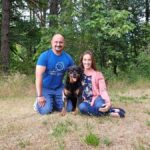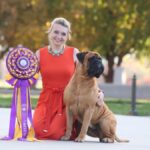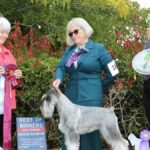Interview with Marnie Layng, Breeder of Mardeck Schipperkes
Where do I live? How many years in dogs? How many years as a breeder?
Marnie Layng: I live in Ontario, Canada, and have participated in the dog world since 1964, eventually breeding my first litter in 1970. I have exhibited and bred Shetland Sheepdogs, Bearded Collies, and Schipperkes, the latter for 40 years.
What is my kennel name? How many dogs do I currently keep?
Marnie Layng: My kennel name is Mardeck, which came about by putting my daughter Marta and son Dereck’s names together. While actively breeding two different breeds, I had as many as 20 dogs, but now I try to keep the numbers of resident Schipperkes down to a manageable two or three. I do still co-own others that live with their owners (58).
Which have been my most influential sires and dams?
Marnie Layng: My most influential sires would have to be “Oz,” AM CAN CH Mardeck’s Whiz Kid De Turenne, ROMX and his son, “Cozmo,” AM CAN NZ GCH Mardeck’s The Sorcerer’s Son, ROM. Cozmo, who now lives in New Zealand at Exmoor with judge Bernard Fears and is at the age of 14, still enjoys the show ring on occasion. AM GCHS, CAN GCHB Mardeck’s Iridessa has made a big impact with her successful show career and by producing “Butter,” MRBIS CAN CH AM CH Mardeck’s The Magic Ingredient who was the No. 1 Schipperke in Canada for 2022. Two of “Dessa’s” offspring have done very well in England, imported by Lesley Thorne, Schipdale. Her daughter, “Shimmer,” UK CH Mardeck’s Shimmering Oasis At Schipdale, won a Best in Show in England in 2022. And Dessa’s son, “Morgan,” AM CAN UK CH Mardeck’s Where The Magic Is At Schipdale, won the prestigious 2022 Nordick Specialty Show in the UK.
Can I talk a bit about my facilities? Where are my puppies whelped? How are they raised?
Marnie Layng: My puppies have always been born and raised in the house, although I do have a kennel attached to the house. I have always ensured puppies are well socialized, and grandchildren really help with that. Pups are exposed to different environments, people, and obstacles, etc., as soon as they can stand up. Many Mardeck dogs have excelled in Performance events as well as Conformation, and I believe this early socialization approach provides a firm foundation for the rest of their lives as companions, performance, and show dogs.
What is my “process” for selecting show puppies? Performance puppies?
Marnie Layng: Show prospects are evaluated on an ongoing basis for sound temperament, physical attributes, and that something special that will give them an edge. Decisions are generally made by nine weeks, then at three months as to whether each is companion only or show potential. Normally, a decision is made by six months if still being grown out.
Does my breed require any special preparation for competing in Conformance? In Performance Events?
Marnie Layng: I’ve always believed that preparation for the Conformation ring and/or Performance event starts when a mating is planned and continues as the pups are born with every human contact and experience. The evidence of this effort is that winning dog that is happy in the ring and still willing to give his all.
In my opinion, is my breed in good condition overall? Any trends that warrant concern?
Marnie Layng: Yes, I do believe overall that the Schip as a breed is in good shape. I have not heard of anything that I am overly concerned about, nor anything that cannot be overcome with sound breeding practices and genetic testing.
Is my breed well suited to be a family dog? Who are the best candidates to own my breed?
Marnie Layng: The Schipperke is known for how well they get along with children. They love to be part of every activity their people are doing. The Schip is a very busy breed and is therefore not necessarily the best choice for people who do not like being active, taking long walks, or have lots of property to allow for adequate exercise. Schipperkes are highly intelligent. They need to be encouraged to use their big brains, so they can learn how to abide by your rules—or they will make up their own. In other words, they need training and exercise.
What is the biggest misconception about my breed? What is my breed’s best-kept secret?
Marnie Layng: Misconception: Probably that they are just a small, cute little dog. They actually think they are big and they are the boss. They are very agile, active, and watchdog-like. Best-Kept Secret: Written history and genetics do not seem to agree on how the Schipperke came to be. We all have our theories, and genetics is presenting new possibilities. Each Schipperke seems to prove that they can herd, retrieve, pull a small cart, show off their collars, or sit on a queen’s lap. Maybe we will never know the actual truth of their original purpose in the 1600s. Maybe this once common little farm dog really has royal genes. Only more time will tell.
As a Preservation Breeder, can I share my thoughts on the sport today? How’s the judging these days? What do you think about the number of shows?
Marnie Layng: The world has changed, so, of course, our sport reflects those changes, both good and bad. What hasn’t changed is that we are unified by our passion for all things canine. We just need to focus on that and try not to fall into the negativity trap. Judging has not changed, nor has exhibitors’ perception of judging. We are, after all, people. I do hope that aspiring judges and new exhibitors will spend more time observing at the shows, such as was necessary when we had benched shows. That is the best way to learn. Watch, ask questions, and get your hands on the dogs, so you can compare them to the Standard and tell the difference between them.
In my opinion, is social media good for the sport? Is it harmful?
Marnie Layng: I think social media is an effective way to communicate and promote our sport. It is not the vessel being used, but the way it is used that makes it powerful. As participants, it becomes our responsibility to use it and view it wisely.
What are the biggest challenges facing the dog show community as a whole today and how can these be addressed?
Marnie Layng: The biggest challenges for the dog community as I see it is the aging population, the availability of venues in which to hold events (shows, training, etc.), and the low membership numbers in so many clubs today. The only way we can preserve the sport is through recruiting and keeping enthusiasts. For many reasons, too many people who enjoy the sport don’t join the clubs that are necessary to hold the events, or don’t give their time to serve the clubs on Boards or committees. Much needs to be done to manage these challenges.
What are some of the positive changes I’ve seen in the dog show community over the past decade?
Marnie Layng: There are so many more tools accessible for breeders now. Geography no longer has to dictate sire selection. There are products to determine when a bitch is ready to breed and even if she is pregnant. Plus, there are databanks of genetic testing and many seminars and tutorials for today’s breeders than ever before.
If I could share one suggestion with judges of my breed, what would I like to say to them about my breed?
Marnie Layng: Don’t make decisions based upon visual examination only. Always ensure through physical touch that what your eyes are seeing is indeed the reality. For instance, coat condition, shedding, etc., can produce an optical illusion such as a dip in the back that doesn’t exist, or a back might appear longer than it is due to less ruff or a tail stub, etc.
For a bit of fun, what’s the most amusing thing I’ve ever experienced with a Non-Sporting Dog?
Marnie Layng: Schipperkes are always entertaining, so I can’t choose just one. To live with one, you must have a sense of humor.








